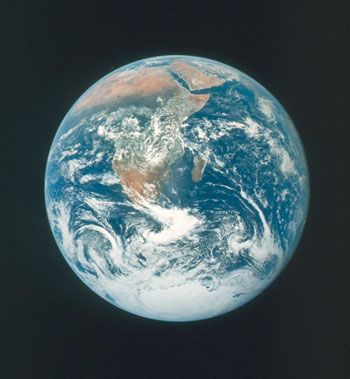The first Earth Day developed as a grassroots movement with teach-ins focused on the environment. I focused on a career in ecology, but Earth Day inspired my commitment to solutions for human impacts on the biosphere. In the ivory tower of Berkeley, applied research was then portrayed as a lower calling to “pure research.” But I was committed to merging fundamental ecology applied to human impacts, now a hallmark of SERC research.
In 1970 the Whole Earth Catalog with its iconic cover image was a major resource for information on sustainability; I still have copies. As Apple’s Steve Jobs points out, this was the precursor to Google in a time before the Internet. Today our access to the World Wide Web allows instantaneous global connection to information, as SERC’s distance learning programs and Web site show well.
The first Earth Day emphasized the future impacts of human population growth, exemplified then by Paul Ehrlich’s book The Population Bomb. In 1970 the world’s population was 3.7 billion. Today it has nearly doubled to 6.8 billion, with projections of more than 9 billion people in another 40 years. Forty years ago 8 million people lived in the Chesapeake watershed; today there are 17 million, headed toward 25 million by 2050. Our economy assumes that growth can be sustained indefinitely, but ecology shows that resources are finite and limit populations at ecosystem carrying capacity. SERC research indicates overfishing by the ever-growing human population is limiting the Chesapeake blue crab stock, like many other fisheries around the world.
The first Earth Day stressed the integration of Earth’s ecosystems. In just 40 years, global change – especially the effects of climate warming – is rapidly overwhelming us. SERC was established just 45 years ago with the prescient purpose of understanding how coastal ecosystems respond to climate change. I hope that you feel the urgency of SERC’s mission to understand and sustain the Earth’s ecosystems over the next 40 years and beyond.
— Anson “Tuck” Hines, Director
Smithsonian Environmental Research Center
To find out how you can support SERC’s research and educational efforts, visit our Web site.



